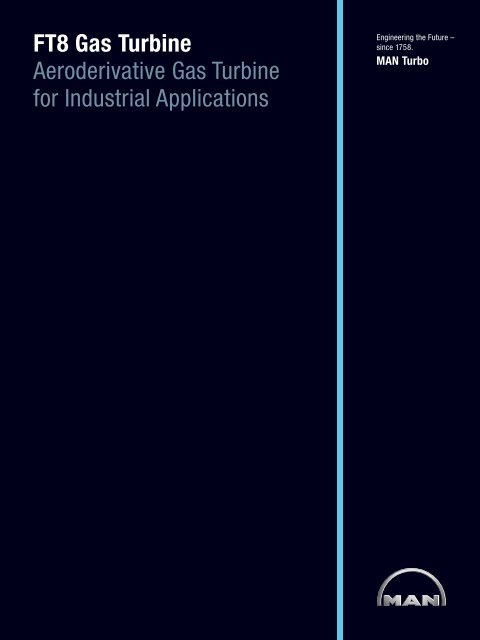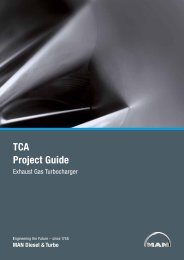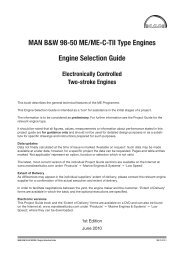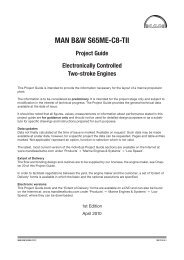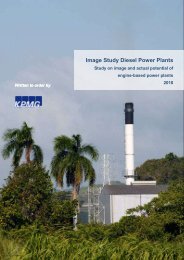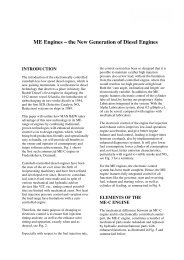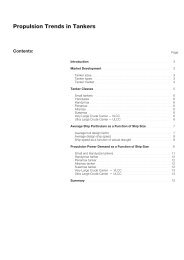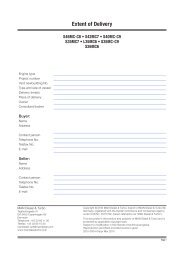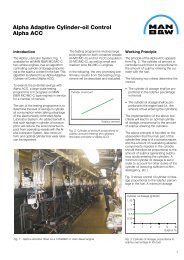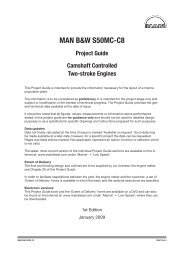FT8 Gas Turbine - MAN Diesel & Turbo
FT8 Gas Turbine - MAN Diesel & Turbo
FT8 Gas Turbine - MAN Diesel & Turbo
Create successful ePaper yourself
Turn your PDF publications into a flip-book with our unique Google optimized e-Paper software.
<strong>FT8</strong> <strong>Gas</strong> <strong>Turbine</strong><br />
Aeroderivative <strong>Gas</strong> <strong>Turbine</strong><br />
for Industrial Applications<br />
Engineering the Future –<br />
since 1758.<br />
<strong>MAN</strong> <strong>Turbo</strong>
Introduction<br />
1 <strong>FT8</strong> on base frame during workshop assembly<br />
2 Cutaway view of the <strong>FT8</strong> (with standard combustion<br />
system)<br />
<strong>MAN</strong> <strong>Turbo</strong> offers the world’s most comprehensive product line of compressors<br />
and turbines. Innovation, ongoing development and modern technology guarantee<br />
the competitiveness of our products (single source solutions) for the lifetime of<br />
a machine.<br />
<strong>Gas</strong> turbines have been included in the range of products since 1988. In 1990,<br />
the gas turbine product line was expanded by adding the <strong>FT8</strong> gas turbine<br />
through signing a co-operation agreement with Pratt&Whitney Power Systems<br />
(PWPS). With the <strong>FT8</strong> gas turbine, <strong>MAN</strong> <strong>Turbo</strong> offers a prime mover, enabling<br />
customers to obtain the reliable, environmentally sound and economic<br />
technology they require for a variety of their applications.<br />
2<br />
1
2<br />
<strong>FT8</strong> <strong>Gas</strong> <strong>Turbine</strong><br />
By mid-2008 more than 370 of the<br />
extremely successful <strong>FT8</strong> gas turbine<br />
packages had been delivered or were on<br />
order. The highly efficient <strong>FT8</strong> gas turbine<br />
consists of a GG8 gas generator and a<br />
PT8 power turbine (also referred to as a<br />
“free-running” turbine). The gas generator<br />
provides high-energy gas to the power<br />
turbine, where this gas performs work<br />
when mechanically coupled to a driven<br />
load through a flexible coupling.<br />
GG8 - <strong>Gas</strong> Generator<br />
The two-shaft gas generator has been<br />
derived from the latest version of the most<br />
successful aero-engine in commercial<br />
service, the Pratt&Whitney JT8D-219,<br />
which has achieved highest recorded<br />
sales of >14,500 engines.<br />
The major components of the gas<br />
generator are the two compressor<br />
modules (LP and HP), the combustion<br />
section and the two turbine modules<br />
(HP and LP).<br />
The LPC (Low Pressure Compressor)<br />
has 8 rotor stages and 7 stator stages.<br />
The inlet guide vanes as well as the first<br />
two stator vane stages have been fitted<br />
with variable geometry. Variable vane<br />
movement provides optimum efficiency<br />
for the compressor over the complete<br />
speed range and excellent part-load<br />
efficiency. The LPC rotor is connected<br />
to the 2-stage LPT (Low Pressure<br />
<strong>Turbine</strong>) rotor by the LP-shaft which is<br />
conducted through the tubular HP-shaft<br />
connecting the HPC (High Pressure<br />
Compressor) with the HPT (High<br />
Pressure <strong>Turbine</strong>).<br />
The HPC consists of seven rotor stages<br />
and seven stator stages and is driven by<br />
the single-stage HPT. With this arrangement<br />
the LP-system and HP-system are<br />
running at their own optimum speed<br />
without mechanical interaction.<br />
Combustion System<br />
Depending on the application the <strong>FT8</strong><br />
gas turbine can be equipped with two<br />
different combustion systems.<br />
The basic version comprises a so-called<br />
“Standard Combustion System” which<br />
permits the use of various gaseous and<br />
liquid fuels – with different specifications<br />
as well as combinations in any percentage<br />
mix and thereby offering high fuel<br />
flexibility.<br />
A DLN (DryLowNOx) combustion system<br />
for gaseous fuel operation is available as<br />
an option. The extremely robust DLN<br />
system allows quick load changes and is<br />
insensitive to changing gas compositions<br />
and ambient conditions.<br />
Standard Combustion System<br />
In the case of the standard combustion<br />
system the combustion section has nine<br />
chambers (cans) arranged in an annulus<br />
around the turbine shafts and positioned<br />
between the High Pressure Compressor<br />
and the High Pressure <strong>Turbine</strong>. The<br />
combustion chambers are enclosed by<br />
inner and outer casings. The outer casing<br />
can be unbolted and moved rearward to<br />
allow for easy inspection or removal of<br />
the combustion chambers and fuel<br />
nozzles.<br />
3
1 Combustion section with burner cans (standard<br />
combustion system)<br />
2 <strong>FT8</strong> gas turbine on base frame with DLN<br />
combustion system<br />
Two combustion chambers accommodate<br />
each one spark plug. During initial<br />
ignition, a flame is propagated from these<br />
two chambers to the remaining chambers<br />
through integral a flame crossover tubes,<br />
which interconnect all nine chambers.<br />
Besides the fuel flexibility, another feature<br />
of the standard combustion system is<br />
its capability to utilize water injection for<br />
NOx-reduction.<br />
DLN (Dry Low NOx) Combustion<br />
System<br />
The DLN combustion system is based<br />
upon an annular Floatwall combustor<br />
which is derived from Pratt&Whitney’s<br />
latest design for new-generation flight<br />
engines.<br />
The combustion system consists of 16<br />
lean premix fuel nozzles and 15 sidewall<br />
pilot nozzles which together establish a<br />
3 zone fuel system to produce the desired<br />
emission levels with stable engine operation.<br />
The lean premix fuel nozzles have<br />
2 fuel zones, a lean premix zone (main<br />
gas flow) and a centrebody pilot zone.<br />
4<br />
1 2<br />
The centrebody pilot zone provides<br />
stabilisation of the lean premix flame<br />
and can be used to control combustor<br />
dynamics. The third fuel zone comprises<br />
the diffusion sidewall pilot nozzles used<br />
for starting, low power operation and for<br />
additional combustor stabilisation.<br />
As for the standard combustion system,<br />
two spark plugs, which are installed into<br />
the annular combustor, are utilized.<br />
As part of the design, Helmholtz resonators<br />
are incorporated into the combustor<br />
section. The thirteen resonators provide<br />
passive control of dynamic pressure<br />
within the combustor.<br />
PT8 Power <strong>Turbine</strong><br />
Different power turbines are available<br />
for both generator and mechanical<br />
drive applications. Each power turbine<br />
incorporates an annular transition duct,<br />
an axial-flow reaction turbine and a<br />
horizontally split main casing followed<br />
by the annular exhaust casing. The<br />
power turbine rotor which is made up of<br />
turbine disks and front/rear shaft ends,<br />
is suspended in antifriction bearings<br />
which are supplied with synthetic lube<br />
oil by a common gas generator/power<br />
turbine lube oil system.<br />
For power generation with grid frequencies<br />
of 50Hz or 60Hz, 4-stage power<br />
turbines are available with design<br />
speeds of 3,000 or 3,600 rpm for CW<br />
(clockwise) and CCW (counter clockwise)<br />
rotation. With this design a direct<br />
coupling of the power turbine to the<br />
(2-pole) electric generator is possible<br />
without the need for a load gear.<br />
For mechanical drive applications in the<br />
upper speed range up to 5,500 rpm,<br />
<strong>MAN</strong> <strong>Turbo</strong> has developed a dedicated<br />
3-stage power turbine with a variable<br />
speed range between 2,500 and<br />
5,500 rpm. This speed variant is mainly<br />
employed in the oil & gas industry for<br />
driving compressors for miscellaneous<br />
applications.
GG8-<strong>Gas</strong> generator<br />
Generator drive applications<br />
PT8-30/36-Power turbine<br />
Mechanical drive applications<br />
n=3,000 rpm<br />
Diffuser<br />
n=3,600 rpm<br />
n=5,500 rpm<br />
PT8-55-Power turbine<br />
Diffuser<br />
Collector box<br />
Modular <strong>FT8</strong> concept for generator drive and mechanical drive applications<br />
5
Configurations<br />
PowerPac<br />
The <strong>FT8</strong> PowerPac includes the skidmounted<br />
gas turbine directly coupled to<br />
the synchronous generator – mounted<br />
on a separate base frame – including all<br />
ancillary equipment required to form a<br />
complete package for outdoor/indoor<br />
installation.<br />
TwinPac<br />
A <strong>FT8</strong>-TwinPac comprises two <strong>FT8</strong> gas<br />
turbines. Each gas turbine is directly<br />
connected to a centrally located doubleend<br />
synchronous generator. Together with<br />
the ancillary equipment, a completely<br />
self-contained package is formed either<br />
for outdoor or indoor installation.<br />
This particular arrangement is only<br />
available for the <strong>FT8</strong> gas turbine because<br />
of the synchronous speed and the<br />
available CW and CCW power turbines.<br />
<strong>MAN</strong> <strong>Turbo</strong>’s partner, Pratt&Whitney<br />
Power Systems (PWPS), has accumulated<br />
many years of sound experience in<br />
the U.S. with their TwinPac units which<br />
are based upon the <strong>FT8</strong> and its predecessor,<br />
the FT4 gas turbine.<br />
6<br />
More than 1100 FT4 gas turbines were<br />
built, with a large number operating in<br />
the TwinPac configuration.<br />
As of May 2008 more than 282 <strong>FT8</strong><br />
gas turbines have been sold in such<br />
TwinPac configurations.<br />
Due to the concept of free-running<br />
power turbines it is possible to shut<br />
down one gas turbine whilst the remaining<br />
gas turbine is kept in operation, providing<br />
maximum operational flexibility in the<br />
case of an occasionally reduced power<br />
demand.<br />
In this case the remaining unit is operating<br />
at optimum efficiency even at 50%<br />
load of the total TwinPac power<br />
output. Should this mode of operation<br />
constitute a major portion of the overall<br />
operational time, overrunning clutches<br />
are available to avoid power turbine<br />
windmilling losses of the gas turbine<br />
which is out of operation. The overrunning<br />
clutches are fully automatic.<br />
A further application where the TwinPac<br />
configuration provides some advantages<br />
is a growing plant capability.<br />
In applications where the power demand<br />
gradually grows, the <strong>FT8</strong> TwinPac<br />
concept offers the option of future<br />
expansion. Initially just one gas turbine<br />
can be coupled to a generator rated for<br />
twice the power output (“½ TwinPac”),<br />
and another <strong>FT8</strong> might be added at a<br />
later stage. All the electrical infrastructure<br />
can be further utilized so that only the<br />
second gas turbine package needs to<br />
be added. The generator efficiency<br />
is kept almost constant in the 50-100%<br />
power range. Thus, the power station<br />
can be adapted to growing requirements.<br />
MechPac<br />
The <strong>FT8</strong> MechPac includes the skidmounted<br />
gas turbine directly coupled to<br />
the driven equipment (compressor) –<br />
mounted on a separate base frame –<br />
including all ancillary equipment required<br />
to form a complete package for outdoor/<br />
indoor installation.
1<br />
2 3<br />
1 Typical MechPac, (Plant<br />
of Wingas, Rueckersdorf,<br />
Germany)<br />
2 Typical PowerPac (Plant of<br />
BOREMER, San Martin de<br />
la Vega, Spain)<br />
3 Typical TwinPac (Plant of<br />
Solvay, Rheinberg, Germany)<br />
7
Package concept<br />
The package concept for the <strong>FT8</strong> offers a<br />
high flexibility as the <strong>FT8</strong> is not completely<br />
pre-packaged at the manufacturer’s workshop<br />
compared to a so-called single-lift<br />
skid.<br />
A single-lift skid has the advantage in<br />
regard of minimizing erection time but is<br />
less flexible with regard to the arrangement<br />
required for indoor installations or<br />
sites with space restrictions.<br />
With the <strong>FT8</strong> package concept the <strong>FT8</strong><br />
gas turbine comes to site first without<br />
an enclosure – pre-mounted and prewired<br />
on a base frame including the fuel<br />
plate and junction boxes – with the<br />
need of minimum space and access<br />
requirements. Having placed the gas<br />
turbine onto the foundation, the enclosure<br />
consisting of pre-fabricated compact<br />
modules is quickly built up.<br />
A further package feature of the <strong>FT8</strong><br />
gas turbine is given by the flexibility of<br />
being able to arrange the auxiliary systems<br />
such as the lube oil system and the<br />
starter equipment module on separate<br />
skids thereby reducing the dimensions<br />
of the main package module to a<br />
8<br />
1 2 3<br />
minimum. An example of an installation<br />
optimized for a building with of less than<br />
9 metres is shown in fig. 4.<br />
As an option the gas turbine package<br />
can be of course designed for outdoor<br />
installation on a "greenfield" site as well<br />
in order to avoid an additional building<br />
and to reduce the investment cost.<br />
The gas turbine acoustic enclosure is<br />
equipped with its own crane system<br />
for rapid exchange of the gas turbine<br />
components during overhauls, thereby<br />
making the need of an external crane<br />
system no longer pertinent.<br />
As a matter of course, <strong>MAN</strong> <strong>Turbo</strong><br />
provides not only supervision but turnkey<br />
installation of its supplied <strong>FT8</strong> gas<br />
turbine packages.<br />
Lubrication system<br />
Unlike other industrialized aero-derived<br />
gas turbines, the <strong>FT8</strong> gas turbine uses a<br />
common lube oil system for both the<br />
gas generator and the power turbine –<br />
based on synthetic oil – which is totally<br />
independent of the mineral lube oil<br />
system of the driven equipment.<br />
Components not integral parts of the<br />
gas turbine are mounted as a preengineered<br />
lube oil package on an<br />
ancillary skid – for ease of maintenance –<br />
next to the gas turbine enclosure<br />
package. This package contains for<br />
example the lube oil reservoir, filters and<br />
motor driven supply – and scavenge<br />
pumps for the power turbine.<br />
The gas generator lube oil supply and<br />
scavenge is executed by mechanically<br />
driven pumps coupled to the accessory<br />
drive-mounted gearbox.<br />
Starting System<br />
The starting system consists of a<br />
hydraulic starter motor mounted on the<br />
gas generator accessory drive gearbox<br />
and a skid-mounted hydraulic start-pac.<br />
Like the ancillary lube oil skid, the<br />
hydraulic starter skid is located outside<br />
of the gas turbine enclosure package<br />
and can be arranged according to the<br />
present specific space constraints.<br />
It will supply high-pressure fluid to the<br />
starter motor geared to the HP compressor<br />
rotor shaft of the gas generator.
approx. 8,900 mm<br />
4<br />
4<br />
1<br />
3<br />
4<br />
approx. 18,900 mm<br />
7<br />
2<br />
8<br />
1 <strong>FT8</strong> during erection<br />
2 Assembly of gas turbine enclosure<br />
3 <strong>Gas</strong> turbine enclosure<br />
4 <strong>FT8</strong> PowerPac at CMST in Graz/Austria<br />
5<br />
6<br />
1 Electro hydraulic start skid<br />
2 Water injection skid<br />
3 Lube oil skid gas turbine<br />
4 Lube oil cooler gas turbine<br />
5 Lube oil skid electrical generator<br />
6 Lube oil cooler electrical generator<br />
7 <strong>FT8</strong> PowerPac<br />
8 Electrical Generator<br />
9
Applications<br />
1 Emergency power station of Kraftnät Aland with<br />
one <strong>FT8</strong> PowerPac<br />
2 Combined power and heat station II (district<br />
heating) of EVO/Germany<br />
3 Emergency power station of Fingrid Oyj with<br />
two <strong>FT8</strong> TwinPacs Source: Fingrid Oyj, Finland<br />
10<br />
1 2<br />
The above-described features of the <strong>FT8</strong> gas turbine in conjunction with its<br />
inherent package concept have mainly led to the following areas of applications<br />
for the <strong>FT8</strong> gas turbine:<br />
Generator Drives<br />
With respect to power generation there<br />
are essentially two different modes of<br />
operation, namely “base load” and<br />
“peak load” operation. Within the socalled<br />
“downstream” sector (e.g. utilities,<br />
paper mills, chemical plants) numerous<br />
<strong>FT8</strong> packages are installed for<br />
base load as well as for peak load operation.<br />
Base load<br />
Due to economical reasons most <strong>FT8</strong><br />
base load applications take advantage<br />
of the additional use of the exhaust heat,<br />
i.e. are working in a cogeneration process.<br />
One example of an <strong>FT8</strong> cogeneration<br />
plant is shown in fig. 2. The Oberhausen<br />
Public Utilities (EVO) power station has<br />
been modified from a 50 MW helium<br />
gas turbine installation to an ultramodern,<br />
automated gas turbine power<br />
station, which supplies the city of Oberhausen<br />
with electric power and heat<br />
(district heating). <strong>MAN</strong> <strong>Turbo</strong>’s scope<br />
comprises beside the <strong>FT8</strong> PowerPac<br />
installation the revamping of the existing<br />
components and building structures.<br />
The gas turbine is equipped with a<br />
standard combustion system allowing<br />
for dual fuel operation. NOx reduction is<br />
performed by means of water injection.<br />
Peak load<br />
Due to its aero-derivative design with<br />
fast start-up and quick loading capability,<br />
the <strong>FT8</strong> gas turbine is furthermore ideally<br />
suited for daily start and stop operation<br />
and thus for peaking applications, i.e.<br />
peak shaving and emergency plants.<br />
Almost all peaking applications of the<br />
<strong>FT8</strong> are utilized for peak shaving<br />
purposes. Due to the excellent starting<br />
reliability the <strong>FT8</strong> is ideally suited for<br />
emergency power generation as well.<br />
The Kraftnät Aland – power generation<br />
station (fig. 1) which is equipped with<br />
<strong>FT8</strong> gas turbines is one example of<br />
such an emergency power generation<br />
application. The contractor is the grid<br />
operator Kraftnät Aland of the island<br />
group Aland which belongs to Finland.<br />
The PowerPac is located in Tingsbacka<br />
close to the connection point of the<br />
subsea power supply cable – coming
3<br />
from Sweden – which provides electrical<br />
energy to the island group. The purpose<br />
of the <strong>FT8</strong> PowerPac is to maintain the<br />
power supply for the island group in<br />
the case of a power supply outage via<br />
the subsea cable. Furthermore the <strong>FT8</strong><br />
PowerPac is being used as a peak shaver<br />
for the electrical grid of the island group.<br />
Consequently, rapid start capability is<br />
of extreme importance. The liquid fuel<br />
operated unit needs only 5 min from<br />
standstill until reaching full load, i.e.<br />
about 25 MW. This unit was taken into<br />
operation in 2005.<br />
A further emergency power station –<br />
based on <strong>FT8</strong>-TwinPacs – is shown in<br />
fig. 3. The contractor is Fingrid Oyj,<br />
which is in charge of the national power<br />
transmission system including organization<br />
of spinning and rapid start capacity<br />
reserves in Finland. The plant, consisting<br />
of two TwinPacs, is located close to the<br />
nuclear power plant OL 1-3 in Olkiluoto,<br />
Finland. On the one hand the plant<br />
is used to stabilize the public power<br />
grid and on the other hand to supply<br />
emergency power to the nuclear power<br />
plant in the case of an outage of the<br />
public grid and other emergency power<br />
supplies in order to keep the cooling<br />
pumps running. Both the stabilizing of<br />
the public grid as well as the secured<br />
power supply to the nuclear power plant<br />
are of highest public interest. Of course,<br />
rapid start capability is therefore of<br />
extreme importance for this installation<br />
too. The liquid fuel operated units need<br />
only 5 min from standstill until reaching<br />
full load, i.e. about 100 MW. These units<br />
were taken into operation in 2007.<br />
11
1 Plant design of the Ruhrgas compressor station<br />
in Werne/Germany<br />
2 <strong>FT8</strong> MechPac at Ruhrgas’s compressor station<br />
in Werne/Germany<br />
3 Three <strong>FT8</strong> MechPacs at Wingas’s compressor<br />
station in Mallnow/Germany<br />
Mechanical Drives<br />
The outstanding efficiency figures,<br />
based on the two-shaft design of the<br />
gas generator and the use of the latest<br />
developments in the aircraft industry,<br />
which are maintained over a wide load<br />
range, in combination with the extreme<br />
robust DLN combustion system, which<br />
allows quick load changes and being<br />
insensitive to changing gas compositions<br />
and ambient conditions make the <strong>FT8</strong><br />
MechPac configuration a reliable and<br />
thus cost-advantageous solution for<br />
mechanical drive applications.<br />
Aside from mechanical drive installations<br />
for UGS (underground storage) and<br />
booster stations (e.g. re-gasification<br />
plants) especially pipeline compressor<br />
stations do have a significant share in<br />
the so called midstream sector.<br />
Especially for the application in pipeline<br />
compressor stations, the <strong>FT8</strong> – driving<br />
centrifugal compressors out of the <strong>MAN</strong><br />
<strong>Turbo</strong>’s product portfolio – has demonstrated<br />
to be a proven and reliable concept<br />
on which the main German gas<br />
12<br />
1 2<br />
distributing companies (Wingas and<br />
Ruhrgas) rely.<br />
The compressor station of Ruhrgas AG<br />
in Werne, Germany, (fig. 2) is a key<br />
installation for gas distribution within<br />
Germany.<br />
In order to expand transport capacities,<br />
two gas turbine compressor units<br />
based upon the <strong>FT8</strong> were added to<br />
complement the compressor plant<br />
already installed. Both <strong>FT8</strong> units are<br />
equipped with the DLN combustion<br />
system.<br />
<strong>MAN</strong> <strong>Turbo</strong>’s scope comprised aside<br />
from the delivery of the turbo machinery<br />
and its accessories the turnkey erection<br />
and commissioning of the gas turbine<br />
compressor units.<br />
At the Polish border, near Frankfurt<br />
Oder, where the JAGAL pipeline is<br />
connected to the JAMAL pipeline,<br />
Wingas GmbH operates a compressor<br />
station which relies on three <strong>FT8</strong><br />
MechPacs. In the course of 2007 this<br />
station was expanded by adding a<br />
waste heat recovery system utilizing<br />
exhaust heat of the gas turbines to<br />
produce steam for a steam turbine<br />
driving a fourth pipeline compressor<br />
(delivered by <strong>MAN</strong> <strong>Turbo</strong>).<br />
Because the Mallnow compressor station<br />
is running 24 hours a day, 365 days a<br />
year – thus a base load installation –<br />
steam is permanently available to power<br />
the steam turbine.<br />
In total, WINGAS operates 8 <strong>FT8</strong><br />
MechPacs distributed on 4 compressor<br />
stations. All these <strong>FT8</strong> units are equipped<br />
with the DLN combustion system.
3<br />
13
Service<br />
1 Borescope inspection on the <strong>FT8</strong><br />
2 Test arrangement for <strong>FT8</strong><br />
It is essential how effectively the value of the machinery is maintained especially<br />
when the gas turbines following their purchase are dedicated to have a service<br />
life running into decades.<br />
Service concept<br />
Early recognition of critical machine<br />
conditions and of faults or malfunctions<br />
that are about to have an impact is an<br />
essential safeguard for the smooth<br />
operation of the gas turbine and thus<br />
the availability of the plant as a whole.<br />
Nevertheless experience has shown<br />
that often unplanned shutdowns are<br />
caused not only by the core equipment<br />
(gas generator /power turbine/driven<br />
equipment) but also by ancillary systems.<br />
Our approach to provide service support<br />
consequently covers the complete gas<br />
turbine plant including all ancillary systems<br />
supplied by <strong>MAN</strong> <strong>Turbo</strong>.<br />
14<br />
1<br />
It is our aim to be there whenever and<br />
wherever you need us, and in consultation<br />
with you, to offer a service tailored to<br />
your requirements – thereby securing<br />
the value of your long-term investment.<br />
<strong>MAN</strong> <strong>Turbo</strong> is today responsible for the<br />
service of around 500 gas turbines<br />
worldwide, and has experts and special<br />
facilities at its disposal for:<br />
erection and commissioning<br />
customer support and diagnosis<br />
spare parts procurement and job<br />
execution<br />
corrective maintenance and inspections<br />
full-load testing<br />
materials examination<br />
Derived from these tasks <strong>MAN</strong> <strong>Turbo</strong><br />
has established a service concept for its<br />
<strong>FT8</strong> product programme which offers<br />
the following features:<br />
<strong>MAN</strong> <strong>Turbo</strong> operates a Pratt&Whitney<br />
approved service shop at the Oberhausen<br />
works taking advantage of the<br />
expertise and skills developed by the<br />
OEM (PWPS)<br />
proactive maintenance<br />
systems for the recording and analysis<br />
of operating and maintenance parameters<br />
(remote data transmission for trend<br />
monitoring and diagnosis of machine<br />
data)
2<br />
Pipeline<br />
compressor<br />
Gear Box<br />
pool gas generators and power turbines<br />
on standby for rental purposes in the<br />
event of scheduled or unscheduled<br />
downtimes so as to minimize downtime<br />
periods<br />
care, support and coordination at the<br />
works of <strong>MAN</strong> <strong>Turbo</strong> of all aspects<br />
relating to components supplied by<br />
<strong>MAN</strong> <strong>Turbo</strong>, including driven equipment<br />
spare parts storage at the Oberhausen<br />
works<br />
exchange of main modules (gas<br />
generator/power turbine) and/or submodules<br />
within a minimum of time<br />
facilities for full-load testing of the <strong>FT8</strong><br />
at the Oberhausen works (see description<br />
below)<br />
wide range of training facilities (see<br />
description below)<br />
Cooling water<br />
Nitrogen cooler 25 MW<br />
Torquemeter<br />
Piping 28"<br />
Throttle valve<br />
<strong>FT8</strong> <strong>Gas</strong> <strong>Turbine</strong> Package<br />
Water injection<br />
system<br />
technical information in the form of<br />
service bulletins<br />
round-the-clock availability of service<br />
personnel<br />
company’s own government-approved<br />
laboratory for materials examination,<br />
research and development<br />
Test facilities<br />
Our test facilities incorporate a dedicated<br />
<strong>FT8</strong> gas turbine test stand allowing us<br />
to test the <strong>FT8</strong> gas turbines even at full<br />
load. Natural gas and/or liquid fuel firing<br />
is possible, permitting simulations of<br />
original operating conditions. The most<br />
modern monitoring systems allow realtime<br />
analysis of the gas turbine during<br />
the test run.<br />
Intake Silencer<br />
Air Filter<br />
Package Ventilation<br />
Lube oil system<br />
Fuel<br />
pumps<br />
Fuel<br />
filter<br />
Compressed<br />
air tank for<br />
air starter<br />
compressor<br />
for<br />
air starter<br />
The test arrangement allows maximum<br />
flexibility with regard to different speeds<br />
of testing <strong>FT8</strong> <strong>Gas</strong> <strong>Turbine</strong>s (50Hz,<br />
60Hz and variable speed in the case of<br />
mechanical drives). Besides that, an<br />
option had to be left open for power turbines<br />
having either right or left direction<br />
of rotation. A precision dynamometer,<br />
located between the power turbine and<br />
a three-shaft special gearbox, is used<br />
for measuring the power turbine torque.<br />
The gearbox steps up/down the output<br />
speed of the gas turbine to correspond<br />
to the speed range of a double-stage<br />
25 MW pipeline compressor (test stand<br />
equipment) which operates in a closed<br />
loop with nitrogen at pressures between<br />
28 and 76 bar.<br />
15
This gas turbine test is in accordance to<br />
ASME PTC-22 with standard exceptions.<br />
Training<br />
Skilled, motivated staff makes a major<br />
contribution to ensuring maximum longterm<br />
availability with minimum service<br />
and maintenance costs. We offer you<br />
training programmes for your staff, from<br />
operators to plant managers. The primary<br />
aims of our training courses are:<br />
To complement and elaborate on the<br />
information contained in the operating<br />
manuals<br />
To optimize operation of the turbo<br />
machinery set<br />
Early detection and elimination of<br />
critical machine states, malfunctions<br />
and faults – including auxiliary systems<br />
Prompt detection of minor damage<br />
that could result in more extensive<br />
damage if ignored<br />
Use of detailed knowledge in maintenance,<br />
inspection, cleaning and<br />
preservation work<br />
16<br />
To achieve these targets we can offer<br />
you a training course that is made-tomeasure,<br />
like your gas turbine plant.<br />
We take your specific requirements into<br />
account when focusing on the content<br />
in order to establish a programme which<br />
fits best to your specific installation and<br />
constraints. Among other things, our<br />
training courses comprise the following<br />
options/services:<br />
Training for specialized staff, fitters,<br />
foremen, technicians, engineers and<br />
plant managers<br />
Training in your company, on our<br />
premises or a combination of the two<br />
Training in German, English or French<br />
as well as in your native language with<br />
simultaneous translation<br />
Organization and coordination of all<br />
measures by a single body – from<br />
compilation of the training documentation<br />
to hotel bookings and outline<br />
programmes.<br />
Should the overall plant contain other<br />
turbo machinery products manufactured<br />
and/or supplied by <strong>MAN</strong> <strong>Turbo</strong>, such as<br />
compressors, generators or steam<br />
turbines, the subjects of the training<br />
programmes of course are expanded<br />
accordingly.
<strong>FT8</strong> test stand with full-load capability<br />
17
Technical data<br />
Power versus temperature (PowerPac)<br />
Power at Generator Terminals (MW)<br />
18<br />
33<br />
30<br />
27<br />
24<br />
21<br />
18<br />
-30 -15 0 15 30 45<br />
Inlet temperature (°C)<br />
Sea level, rel. humidity = 60%<br />
Natural gas<br />
No inlet/outlet losses<br />
Standard combustion system<br />
Generator efficiency: 98%
Mechanical Drive <strong>FT8</strong> PowerPac <strong>FT8</strong> TwinPac <strong>FT8</strong> MechPac<br />
Shaft power kW - - 25,870<br />
HP - - 34,690<br />
Thermal efficiency % - - 38.6<br />
Heat rate kJ/kWh - - 9,330<br />
Btu/HPh - - 6,594<br />
Generator Drive<br />
Power at generator<br />
terminals kWe 25,570 51,140 -<br />
Electrical efficiency % 38.1 38.1 -<br />
Heat rate kJ/kWh 9,440 9,440 -<br />
Btu/kWh 8,950 8,950 -<br />
Exhaust <strong>Gas</strong> Data<br />
Exhaust gas temperature °C 458 458 457<br />
°F 856 856 855<br />
Exhaust gas mass flow kg/s 85.1 170.2 85.9<br />
lb/s 188 376 189<br />
<strong>Gas</strong> Generator (LP/HP)<br />
Speed rpm 7,100/11,520 7,100/11,520 7,100/11,520<br />
Compressor stages 8/7 8/7 8/7<br />
<strong>Turbine</strong> stages 2/1 2/1 2/1<br />
Weight approx. (DLN) kg 3,000 (3,950) 3,000 (3,950) 3,000 (3,950)<br />
Power <strong>Turbine</strong><br />
Speed rpm 3,000* 3,000* 2,500-5,500<br />
Stages 4 4 3<br />
Weight approx. kg 6,000 6,000 5,100<br />
Above specifications valid under the following conditions:<br />
15°C (59°F), sea level, no inlet/outlet losses, RH = 60%, natural gas, �<br />
gen.<br />
= 98%<br />
* 3,600 rpm available on request<br />
19
<strong>MAN</strong> <strong>Turbo</strong> AG<br />
Steinbrinkstrasse 1<br />
46145 Oberhausen/Germany<br />
Phone +49. 208. 6 92-01<br />
Fax +49. 208. 6 92-20 19<br />
www.manturbo.com<br />
<strong>MAN</strong> <strong>Turbo</strong> – a member of the <strong>MAN</strong> Group<br />
In the interests of technical progress,<br />
subject to change without notice.<br />
Printed in Germany. February 2009<br />
<strong>Turbo</strong> 1005 e 0109 0,1 ba


